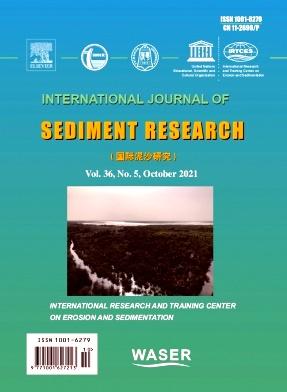Three-dimensional numerical modeling of sediment transport in a highly turbid estuary with pronounced seasonal variations
IF 3.5
2区 环境科学与生态学
Q2 ENVIRONMENTAL SCIENCES
引用次数: 0
Abstract
Simulating sediment dynamics in a large and energetic estuary system remains challenging, primarily due to the spatial and temporal complexities of the interaction between flow and sediment transport, especially for sand-mud mixtures. This study uses a three-dimensional (3D) numerical model, based on the open TELEMAC system, to investigate the dynamics of suspended sediment concentration (SSC) in the Gironde Estuary, a complex estuarine environment characterized by an estuarine turbidity maximum (ETM) and significant variations in river discharge. The main contributions of this study include addressing the challenges of coupling bed friction with sediment transport of the sand-mud mixture for feedback on bed roughness and bottom depth changes and the ability of the model to capture the migration of ETM from high to low flow. Additionally, the current study analyzes the ability of the model to capture the migration of ETM from high to low flow, and it utilizes a calibration strategy that minimizes parameters by using in situ data and encompassing hydro–morpho-sedimentary interactions. A sensitivity analysis was done using different settling velocity approaches and sediment classes to establish an optimal model configuration and the uncertainty associated with the reduced model parameterization is discussed. The model satisfactorily reproduces the hydrodynamic features, particularly when the hydro-sedimentary feedbacks are taken into account, the seasonal trend of SSC, spring-neap variations, and the development of a well-defined ETM. The selection of a specific formulation for the settling velocity influences the location and magnitude of ETM. The van Leussen formula not only predicts a broad movement of ETM from high to low river flow, but also predicts high turbidity for extended periods during low river flow. Conversely, two empirical formulas from Le Hir and Defontaine predicted the highest turbidity during neap tides but sediment losses during prolonged simulations. The results of this study contribute to a deeper understanding of sediment dynamics in the Gironde Estuary, providing valuable information for future estuarine modeling and management.
具有明显季节变化的高浑浊河口泥沙输运的三维数值模拟
在一个大而充满活力的河口系统中模拟泥沙动力学仍然具有挑战性,主要是由于水流和泥沙运输之间相互作用的时空复杂性,特别是沙-泥混合物。本文采用基于开放式TELEMAC系统的三维(3D)数值模型,研究了吉伦特河口悬沙浓度(SSC)的动态变化。吉伦特河口是一个以河口浊度最大值(ETM)和河流流量变化显著为特征的复杂河口环境。本研究的主要贡献包括解决了将床层摩擦与沙泥混合物的沉积物输移耦合起来的挑战,以反馈床层粗糙度和底部深度变化,以及模型捕捉ETM从高流到低流迁移的能力。此外,目前的研究分析了该模型捕捉ETM从高流量到低流量迁移的能力,并采用了一种校准策略,通过使用原位数据和包含水-形态-沉积相互作用来最小化参数。采用不同沉降速度方法和沉积物类型进行敏感性分析,建立了最优模型配置,并讨论了模型参数化的不确定性。该模型令人满意地再现了水动力特征,特别是考虑了水-沉积反馈、SSC的季节趋势、春季小潮变化和明确的ETM的发展。沉降速度的特定公式的选择影响着ETM的位置和大小。van Leussen公式不仅预测了ETM从高流量到低流量的广泛移动,而且还预测了低流量期间长时间的高浊度。相反,Le Hir和Defontaine的两个经验公式预测小潮期间浊度最高,但长时间模拟期间泥沙损失最大。研究结果有助于深入了解吉伦特河口沉积动力学,为未来河口建模和管理提供有价值的信息。
本文章由计算机程序翻译,如有差异,请以英文原文为准。
求助全文
约1分钟内获得全文
求助全文
来源期刊
CiteScore
6.90
自引率
5.60%
发文量
88
审稿时长
74 days
期刊介绍:
International Journal of Sediment Research, the Official Journal of The International Research and Training Center on Erosion and Sedimentation and The World Association for Sedimentation and Erosion Research, publishes scientific and technical papers on all aspects of erosion and sedimentation interpreted in its widest sense.
The subject matter is to include not only the mechanics of sediment transport and fluvial processes, but also what is related to geography, geomorphology, soil erosion, watershed management, sedimentology, environmental and ecological impacts of sedimentation, social and economical effects of sedimentation and its assessment, etc. Special attention is paid to engineering problems related to sedimentation and erosion.

 求助内容:
求助内容: 应助结果提醒方式:
应助结果提醒方式:


